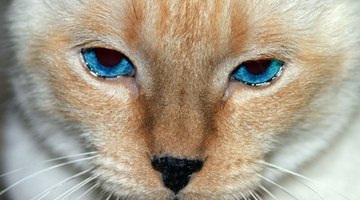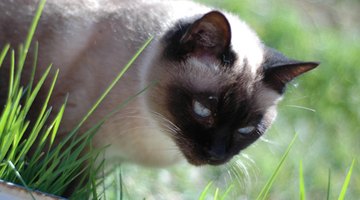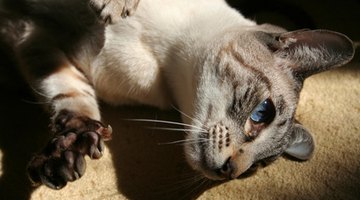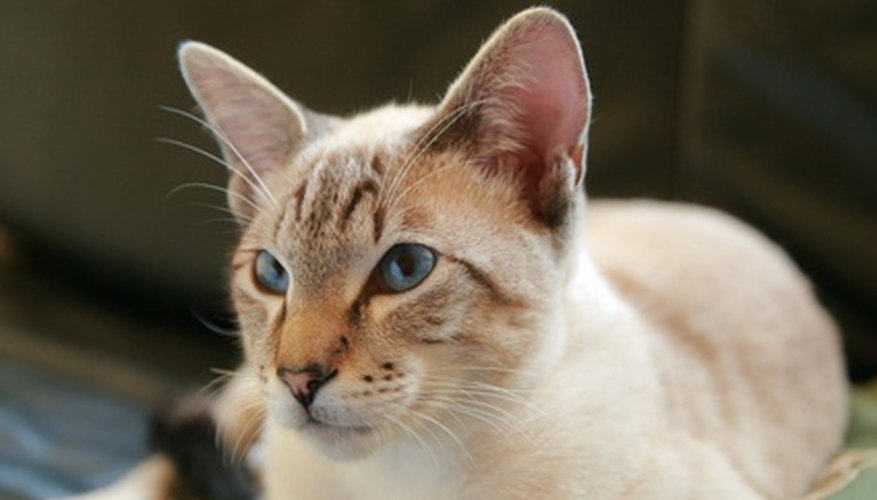Siamese cats often suffer unusual patterns of hair loss. This commonly shows itself by thinning of the hair inside the back legs or on the abdomen, but can also occur on the ears, tail and spine. This breed suffers genetic hair loss known as congenital alopecia or hypotrichosis; while genetic hair loss cannot be ruled out, it is necessary to understand other possible causes.
Environmental Causes

Primary causes tend to be environmental. Many Siamese are allergic to house dust mites, causing baldness; forced--air heating exacerbates this problem. Fleas in the home are also a common cause. The Siamese cat's coat is dense and harbours fleas and parasites without an owner ever seeing any signs. A cat with fleas will be persistently scratching, washing and biting its skin.
- Primary causes tend to be environmental.
- The Siamese cat's coat is dense and harbours fleas and parasites without an owner ever seeing any signs.
Physiological Causes

Siamese with the inherited hormone condition "endocrine alopecia" cannot grow new fur because of an imbalance in oestrogen, thyroid hormone and testosterone. They lose fur on thighs, tail and abdomen. Some can lose hair due to insufficient hair follicles; a veterinarian may biopsy the skin looking at hair follicle prevalence. Ringworm is another hair-loss cause, especially in multi-cat environments. This is a fungal infection of the skin causing lesions and bald patches, commonly on the ears, paws and tail. It spreads quickly to other areas and to people. Ringworm can cause open sores in a ring pattern, hence the name.
- Siamese with the inherited hormone condition "endocrine alopecia" cannot grow new fur because of an imbalance in oestrogen, thyroid hormone and testosterone.
- Some can lose hair due to insufficient hair follicles; a veterinarian may biopsy the skin looking at hair follicle prevalence.
Behavioural Causes

Some Siamese lose hair for behavioural reasons, notably when stressed. A stressed cat may over-groom; some pluck their fur in a specific place, or wash to a point where bald patches appear. Stress at home is the most common cause. It's often seen when a new pet is introduced, when a household becomes unusually busy or noisy, or when a new baby comes into the family. The owners' absence from home may also be a factor, as is leaving a cat alone or in cattery. Siamese cats are interactive; left unstimulated they soon become frustrated.
- Some Siamese lose hair for behavioural reasons, notably when stressed.
- A stressed cat may over-groom; some pluck their fur in a specific place, or wash to a point where bald patches appear.
Treatments
Hormonal imbalances causing baldness need a veterinary hormone prescription. Flea-induced hair loss is treated by regular administration of a veterinary flea treatment. These usually work by killing live fleas, but also interrupt the fleas' reproductive cycle. Ringworm is treated with anti-fungal baths and oral drugs, such as itraconazole or griseofulvin. However, it's also vital to treat the environment by daily vacuuming, soft-surface steaming and disinfecting, which will help address a cat's dust-mite and flea-allergic responses, too. To keep Siamese stress-free, ensure they have a quiet, but stimulating home with plenty of toys, time and attention.
- Hormonal imbalances causing baldness need a veterinary hormone prescription.
- However, it's also vital to treat the environment by daily vacuuming, soft-surface steaming and disinfecting, which will help address a cat's dust-mite and flea-allergic responses, too.
Helpful Products

Siamese suffering behavioural problems respond well to pheromone (synthetic hormone) plug-ins obtained from the veterinary practice. These work on the principle of distributing contented cat scent throughout the environment. They're particularly helpful in multi-cat homes. Providing Siamese with tall indoor cat trees, lots of toys and safe outdoor areas will also alleviate stress behaviours.
- Siamese suffering behavioural problems respond well to pheromone (synthetic hormone) plug-ins obtained from the veterinary practice.
- These work on the principle of distributing contented cat scent throughout the environment.
